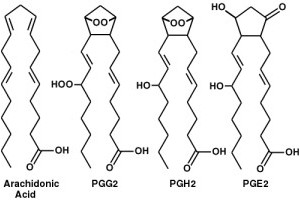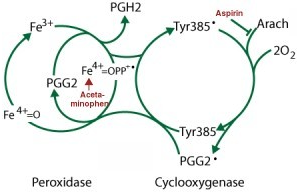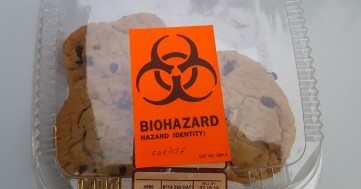 motions give our lives direction and purpose. They can force us to chase after
things we can never attain, to sacrifice our lives for those we care about, to
change our opinions, and to take action on some issue. An authentic distress call
automatically terrifies us, and a beautiful face or painting can move us to tears.
When emotions go out of control they can easily ruin our lives. Little wonder
Mister Spock avoids them.
motions give our lives direction and purpose. They can force us to chase after
things we can never attain, to sacrifice our lives for those we care about, to
change our opinions, and to take action on some issue. An authentic distress call
automatically terrifies us, and a beautiful face or painting can move us to tears.
When emotions go out of control they can easily ruin our lives. Little wonder
Mister Spock avoids them.
But how do they work? One clue comes from the painkiller acetaminophen, which seems to act as an emotional inhibitor. This is not solely due to an anti-inflammatory effect, because aspirin has no such effect. To review: aspirin relieves pain by blocking an enzyme called cyclooxygenase-2, or COX-2, which converts arachidonic acid into prostaglandin H2 (PGH2), an important lipid for the inflammatory response. Aspirin is unique: it is the only NSAID (non-steroidal anti-inflammatory drug) that covalently and irreversibly inhibits COX-1 and COX-2.

Structure of arachidonic acid, PGG2, PGH2, and PGE2
Acetaminophen (aka paracetamol) was invented way back in 1878, but was mistakenly thought to be toxic, so phenacetin was used instead. In 1948, Julius Axelrod and Bernard Brodie proved that the active metabolite of phenacetin was acetaminophen, and acetaminophen took off.
However, the way it works is still not clear. It is said to have weak effects on COX-1 and 2, but because it has no effect on peripheral inflammation, people decided it should not be called an NSAID. For a time everyone thought that COX-3, a splice variant of COX-1 found in the brain, was its actual target (see table). But it turned out that, while COX-3 is indeed strongly inhibited by acetaminophen, COX-3 is only functional in dogs, not in humans. Another great theory down the toilet.
Old theory| Painkiller | COX-1 | COX-2 | COX-3 |
|---|---|---|---|
| Aspirin | Inhibits | Inhibits | |
| Acetaminophen | Inhibits | Inhibits |
As it happens—and this is why we biochemists make the big bucks—the cyclooxygenase reaction turned out to be really complicated. Those of you who aren't biochemists should look away now. You can just skip the next three paragraphs and say I told you the cell does it by waving its magic wand.
Mechanism of action of acetaminophen

This diagram shows the chemical reactions that occur at the two catalytic sites of the cyclooxygenase enzyme. Aspirin inhibits the cyclooxygenase site and acetaminophen (aka paracetamol) is a reducing agent that reacts with the Fe4+ on the peroxidase site. A dot indicates a free radical.
To understand how this molecule works, we have to look at the gory details of COX-1 and 2. COX, also known as prostaglandin H synthase, cyclooxygenase, or PGHS, is a bifunctional enzyme. In the first step (at right on one of my old slides), it acts as an oxygenase by adding two oxygens to arachidonic acid to create a cyclic peroxide-hydroperoxide called PGG2. Then in the second step, it acts as a peroxidase by reducing the hydroperoxide (an OOH group) in PGG2 to an alcohol (an OH group), creating PGH2. PGH2 is important because it can be converted other molecules such as PGE2, prostacyclin, and thromboxanes. Some of these molecules are pro-inflammatory, others are anti-inflammatory, and some just do other stuff that nobody cares about. By the way, this will all be on the test!
In the oxygenase step, COX needs a free radical on its tyrosine (Tyr385•). In the peroxidase step, the hydroperoxide oxidizes an iron atom (Fe3+) to a highly reactive and very unusual Fe4+ state. This iron is complexed with a big molecule to make something called a ferryl protoporphyrin IX radical cation (Fe4+=OPP•+). This cation transfers its extra electron to Tyr385, re-generating the free radical the enzyme needs for the next cycle. Acetaminophen interferes with this, by somehow giving an electron to Fe4+ and reducing it back to Fe3+. This means fewer Tyr385 radicals get formed and the giant molecular machine grinds to a halt.

Latest theory of the mechanism of action of acetaminophen
So acetaminophen really does inhibit COX-1 and 2, but only in the brain where the free arachidonic acid concentration is very low. At least, that's the current theory[1]. Other researchers say it inhibits reuptake of anandamide, the endogenous molecule that binds to the THC receptors. Like the prostaglandins, anandamide is an arachidonic acid metabolite. But most people have pretty much given up trying to figure out how acetaminophen works, and we all just think of it as a molecular magic wand.
Acetaminophen and empathy
Okay, so where were we? Empathy-like behavior can be reduced by a single high dose or by repeated low doses of acetaminophen[2]. This is now well established, but the mechanism is not clear. It's been suggested [3] that there's an overlap between experienced pain and empathy for others' pain, and that acetaminophen reduces empathy to others' pain by blocking the observer's pain. If so, empathy is literally feeling someone else's pain, much as Bill Clinton claimed to do, although based on the surprised expression of the woman sitting next to him there is some dispute about what it was that Bill Clinton was actually feeling.
There is evidence that acetaminophen's effect is due to inhibition of oxytocin release. Oxytocin has acquired the reputation of being the empathy or “kindness” hormone. But of course it's not just that. It's used clinically to strengthen labor contractions. It can cause runny nose, loss of appetite, seizures, and memory problems. Acetaminophen also reduces in-hospital delirium in patients undergoing cardiac surgery.[4] And if you take too much, acetaminophen is a great way to destroy your liver.
There's a clear connection between negative emotions and nociceptive (pain) processing. Mice lacking KChIP3, aka calsenilin, have higher pain sensitivity and stronger negative emotions[5]. KChIP3 also represses TNFAIP3 (TNFα-induced protein 3, aka A20), a protein that suppresses NFκB, which is a roundabout way of saying it mediates inflammation[10]. So there's a lot more to this than the mouse just being pissed about being in a state of pain, although it's probably hard to tell the difference.
Other classes of painkillers, such as opioids, aren't particularly noted for inhibiting emotions. In the brain, opioid receptors are activated by endorphins, producing an analgesic effect.
Inflammation is painful, and the pain signals are mediated by PGE2—which, like oxytocin, is used to induce labor, inhibit bleeding after delivery, and to terminate pregnancy. It turns out that oxytocin induces the release of PGE2[6,7].
To summarize: Inflammation = PGE2 = pain. Oxytocin = PGE2 = empathy. Acetaminophen = no oxytocin. Therefore we get the old saying: No pain, no oxytocin. No oxytocin, no empathy.
Depression is also associated with neuroinflammation, and interferon-α, a pro-inflammatory cytokine used to treat autoimmune diseases, viruses, and cancer, plunges 30–70% of patients receiving it into a prolonged state of depression. This is a big problem in clinical settings where interferon is used.
So, what does all this mean? Are emotional feelings a form of inflammation? Emotional feelings, like pain, can be mimicked by specific drugs. So we also need the mental component or the emotion will not feel real. Many people think there may be connection. But so far the research is very soft.
Cookies

Chocolate chip cookies
What about chocolate chip cookies? Chocolate contains theobromine, a stimulant similar to theophylline. It also contains polyphenols, (−)-epicatechins, and their oligomers known as procyanidins that supposedly have anti-inflammatory effects[8]. Some reports claim that chocolate reduces blood levels of C-reactive protein, a marker for inflammation. Theobromines inhibit the differentiation of preadipocytes and reduce the circulating levels of proinflammatory cytokines MCP-1 and IL-1β[9]. So chocolate might reduce unpleasant emotions in some people, but as far as I know there are no studies on this.
The brain is notorious for using biochemical pathways for things other than their original purpose. It might just have been handy for the brain to take the pre-existing pain pathways and tweak them into new emotional feelings, or they might have evolved blindly and independently, guided only by their effects on our behavior—a form of communication.
Certainly a Mister Spock would think so. On the other hand, there is no record of Spock ever having eaten a chocolate chip cookie. That, he would probably say, would be illogical.
1. Jóźwiak-Bȩbenista M, Nowak JZ. (2014). Paracetamol: mechanism of action, applications and safety concern. Acta Pol Pharm. 71, 11–23. Review. PMID: 24779190
2. Kandis S, Ates M, Kizildag S, Camsari GB, Yuce Z, Guvendi G, Koc B, Karakilic A, Camsari UM, Uysal N. (2018). Acetaminophen (paracetamol) affects empathy-like behavior in rats: Dose-response relationship. Pharmacol Biochem Behav. 175, 146–151. doi: 10.1016/j.pbb.2018.10.004. PMID: 30359628
3. Mischkowski D, Crocker J, Way BM. (2016). From painkiller to empathy killer: acetaminophen (paracetamol) reduces empathy for pain. Soc Cogn Affect Neurosci. 11(9), 1345–1353. doi: 10.1093/scan/nsw057. PMID: 27217114
4. Subramaniam B, Shankar P, Shaefi S, Mueller A, O'Gara B, Banner-Goodspeed V, Gallagher J, Gasangwa D, Patxot M, Packiasabapathy S, Mathur P, Eikermann M, Talmor D, Marcantonio ER. (2019). Effect of Intravenous Acetaminophen vs Placebo Combined With Propofol or Dexmedetomidine on Postoperative Delirium Among Older Patients Following Cardiac Surgery: The DEXACET Randomized Clinical Trial. JAMA 321(7), 686–696. doi: 10.1001/jama.2019.0234. PMID: 30778597
5. Guo YP, Zhi YR, Liu TT, Wang Y, Zhang Y. (2019). Global Gene Knockout of Kcnip3 Enhances Pain Sensitivity and Exacerbates Negative Emotions in Rats. Front Mol Neurosci. 12:5. doi: 10.3389/fnmol.2019.00005. PMID: 30740043
6. Chen D, Zhao J, Wang H, An N, Zhou Y, Fan J, Luo J, Su W, Liu C, Lia J (2015). Oxytocin evokes a pulsatile PGE2 release from ileum mucosa and is required for repair of intestinal epithelium after injury. Sci Rep. 5, 11731. doi: 10.1038/srep11731 PMID: 26159321
7. Welch MG, Margolis KG, Li Z, Gershon MD. (2014). Oxytocin regulates gastrointestinal motility, inflammation, macromolecular permeability, and mucosal maintenance in mice. Am J Physiol Gastrointest Liver Physiol. 307(8), G848–G862. doi: 10.1152/ajpgi.00176.2014. PMID: 25147234
8. di Giuseppe R, Di Castelnuovo A, Centritto F, Zito F, De Curtis A, Costanzo S, Vohnout B, Sieri S, Krogh V, Donati MB, de Gaetano G, Iacoviello L. (2008). Regular consumption of dark chocolate is associated with low serum concentrations of C-reactive protein in a healthy italian population. J Nutr. 138, 1939–1945.
9. Fuggetta MP, Zonfrillo M, Villivà C, Bonmassar E, Ravagnan G. (2019). Inflammatory Microenvironment and Adipogenic Differentiation in Obesity: The Inhibitory Effect of Theobromine in a Model of Human Obesity In Vitro. Mediators Inflamm. 1515621. doi: 10.1155/2019/1515621. PMID: 30804705
10. Tiruppathi C, Soni D, Wang DM, Xue J, Singh V, Thippegowda PB, Cheppudira BP, Mishra RK, Debroy A, Qian Z, Bachmaier K, Zhao YY1, Christman JW, Vogel SM, Ma A, Malik AB (2014). The transcription factor DREAM represses the deubiquitinase A20 and mediates inflammation. Nat Immunol. 15, 239–247. doi: 10.1038/ni.2823. PMID: 24487321
march 02 2019, 5:13 am. edited for brevity mar 03 2019, 3:15 pm. structures added mar 03 2019, 5:41 pm


